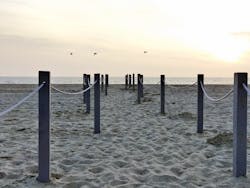About the author: Melodie Grubbs is watershed programs manager for The Bay Foundation. Grubbs can be reached at [email protected] or 310.417.3962.
The beaches of Los Angeles County, Calif., are some of the most recognizable and popular in the world. They feature cliffs, tide pools and marine life, and provide recreational opportunities for the millions of people who visit the coastline each year. Although sandy beaches traditionally have been and continue to be managed primarily as recreation areas, they also are important natural ecosystems that link marine and terrestrial environments and are considered major habitats.
The protection of sandy beaches and an understanding of their condition has become increasingly important in their relationship to coastal resilience, as beaches provide a first line of defense from coastal hazards brought by sea level rise, increased weather events and erosion processes. Sandy beaches in the region have been altered by human activities such as sand replenishment, daily mechanized grooming, vehicular transport and the removal of native vegetation. An associated loss of natural beach morphology threatens not only the beaches themselves, but also the highly developed infrastructure hugging the coastline.
Figure 1. Map of Santa Monica Beach Restoration Pilot
Beach Restoration Pilot
In late 2016, The Bay Foundation (TBF) partnered with the city of Santa Monica to implement the Santa Monica Beach Restoration Pilot Project. The project aims to evaluate "softscape" protection measures against sea level rise and coastal storms as an alternative to traditional hardscaping options. A living shoreline approach to coastal protection enhances the ability of the coastline to serve as a buffer, protecting inland infrastructure from flooding. Hardscape engineering, like sea walls and jetties, can have negative effects on local and adjacent beach habitats, are often costly, and can disrupt normal patterns of wind, wave and current movement that drive sediment exchange. The Santa Monica Beach Restoration Pilot Project is inexpensive and easy to construct, and will be self-sustaining once vegetation establishes and sand accretion begins.
Sand fencing and a pathway delineate the 3-acre beach restoration site, which was seeded with native California foredune plant species. Small dunes begin to form when wind-blown sand becomes trapped along fencing and in established vegetation and wrack. The vegetation community, which includes beach evening primrose (Camissoniopsis cheiranthifolia) and red sand verbena (Abronia maritima), are adapted to harsh beach environments, provide habitat to shorebirds and invertebrates, and promote dune formation. Thousands of seedlings already can be observed on site, and as the vegetation continues to grow, sand accretion will increase. This process can continue as long as the vegetation community is robust and healthy.
Project Benefits
Four months after project implementation, a federally threatened western snowy plover (Charadrius nivosus nivosus) nest was discovered at the site. These tiny shorebirds have not nested in Los Angeles County for nearly 70 years.
After decades of beach alteration, including sand grooming practices and nourishment projects and impacts from coastal development, even a little effort in beach restoration can go a long way. The ecosystem benefits that living shoreline projects like this provide continue over time as the shoreline changes in response to vegetation, root systems, accretion of sand sediments and wrack. This function is divergent from hard shorelines that require maintenance and often result in negative impacts to sandy beach habitats.
In addition to shoreline stabilization and protection from coastal storms, this project also will provide enhanced ecosystem services to the community, including water quality improvement, carbon sequestration and food production.
A comprehensive monitoring plan accompanies the pilot project to provide data to inform future beach restoration projects in the region. Vegetation, invertebrate and bird surveys will assess the biological health of the system, and high-resolution elevation, sand grain and sand transport data will monitor dune formation progress. The formation of small dune hummocks already is apparent from recent topographic surveys. TBF has engaged coastal scientists throughout the region to participate in monitoring efforts, and the site has provided a research opportunity for more than a dozen university students so far.
The project is synchronous with the city of Santa Monica’s efforts to update its Local Coastal Plan and integrate possible outcomes and adaptation strategies with sea level rise and intensifying storm patterns. Eventually, the project could inform policy discussions on how the city will mitigate sea level rise impacts on coastal assets. The project has been well-received by the general community, showing that existing recreational beach use and meaningful habitat restoration are not incompatible goals.
In the face of climate change, this “wild beach” could inform the future of coastal management practices and policy.
Site Vegetation such as red sand verbena (left) and evening primrose (right) have adapted to the harsh beach environment.


